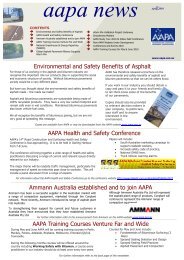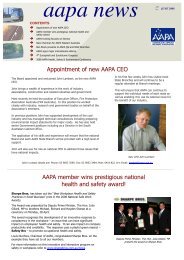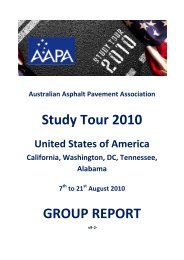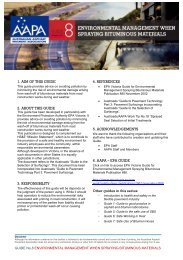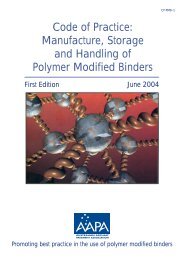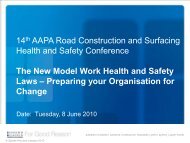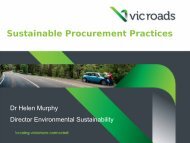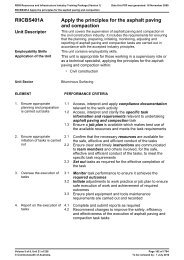Asphalt Review - Volume 29 Number 2 (June / July 2010)
Asphalt Review - Volume 29 Number 2 (June / July 2010)
Asphalt Review - Volume 29 Number 2 (June / July 2010)
Create successful ePaper yourself
Turn your PDF publications into a flip-book with our unique Google optimized e-Paper software.
ASPHALT REVIEW<br />
CEO’s report<br />
I am writing this just as the 14th AAPA<br />
Road Construction and Surfacing<br />
Health and Safety Conference has<br />
concluded. There were many very<br />
interesting discussions and we will<br />
feature some of these in the next edition<br />
of <strong>Asphalt</strong> <strong>Review</strong>.<br />
The conference raised a range of<br />
issues from the structure of various<br />
bitumen hoses to the new national<br />
model health and safety laws. It<br />
also discussed a range of technical<br />
innovations and legislative issues such<br />
as the traffic management registration<br />
scheme in Queensland.<br />
One of the highlights of the<br />
conference was the papers on safety<br />
around road construction work sites,<br />
particularly on the benefits of reducing<br />
motorist speed around those sites to<br />
zero; that is to close the road. These<br />
discussions were followed by a panel<br />
discussion and workshop on working<br />
under traffic, speed management and<br />
enforcement.<br />
These discussions noted that some<br />
motorists may be distracted as they<br />
pass worksites. They may be using their<br />
mobile phone, changing their radio<br />
station or even having a morning coffee.<br />
Others may be affected by drink or<br />
drugs. In some cases, motorists are just<br />
in a hurry and ignore speed limits.<br />
The preferred safety option is therefore<br />
to close the road. Road closures not only<br />
increase safety, they also usually result<br />
in significant cost and time savings. But<br />
it is not always possible to close a road.<br />
In these cases, it is important that all<br />
those involved in the project continue<br />
to focus on safety with the aim always<br />
being zero incidents.<br />
To achieve this requires every<br />
person involved to be vigilant. Traffic<br />
controllers must be suitably trained<br />
and equipped, signage must be accurate<br />
and visible – and removed when it is<br />
not required. Protective barriers must<br />
be well positioned and designed –<br />
including filling plastic barriers with<br />
water and securing them together.<br />
Appropriate clothing is also essential,<br />
both day and night.<br />
Another significant part of the<br />
conference was a workshop for health<br />
John Lambert,<br />
CEO, AAPA<br />
and safety representatives from AAPA<br />
branches to meet and identify key areas<br />
that AAPA should focus on over the next<br />
two years. This workshop identified<br />
a number of potential opportunities<br />
including preparing an AAPA model<br />
check list to be used when closing a<br />
worksite to ensure signage is removed,<br />
better sharing of industry alerts and<br />
providing industry-relevant training to<br />
handle dangerous goods.<br />
A report on this workshop will be<br />
prepared for discussion in the AAPA<br />
State Branches.<br />
Many of the delegates at the conference<br />
commented that it was a great success<br />
and that they will be taking a lot of<br />
significant learnings from it. I would<br />
therefore like to thank Scott Mathews<br />
and Denise McQueen from Hallmark<br />
Editions, the conference organisers,<br />
for a great conference. I also thank<br />
the Platinum Sponsor, Fulton Hogan,<br />
and Bronze sponsor, Sparke Helmore<br />
Lawyers, as well as all the presenters<br />
who put so much into this conference.<br />
The other major event that has<br />
occurred recently in our industry is the<br />
commencement of the AAPA/Austroads<br />
Warm Mix Validation Project. This is a<br />
major project supported by AAPA and<br />
state road authorities to validate the<br />
hypothesis that warm mix is equal or<br />
better than hot mix asphalt. There is an<br />
article in this edition of <strong>Asphalt</strong> <strong>Review</strong><br />
detailing this project and I recommend<br />
that you read it.<br />
The project highlights the strength of<br />
AAPA to bring together both industry<br />
and state road authority members to<br />
work together for the common good of<br />
our industry.<br />
AAPA has successfully worked for 40<br />
years to support our industry and will<br />
continue to do so for many years to<br />
come. The warm mix project is just one<br />
example of many significant projects<br />
that have and are being undertaken<br />
nationally and in individual states. For<br />
example; at present AAPA is currently<br />
undertaking studies into perpetual<br />
pavements, sprayer calibration and<br />
skid resistance. It is also constantly<br />
updating its training courses and<br />
in conjunction with Austroads, the<br />
Pavement Work Tips series.<br />
Through its liaison groups, AAPA<br />
is bringing together industry and<br />
government agencies to help grow<br />
our industry and make even better<br />
roads. Most recently, this has led to a<br />
Bituminous Surfacing Working Group<br />
being established in the Northern<br />
Territory. A State Executive Officer is<br />
also being sought in Western Australia<br />
to support our industry in that state.<br />
An advertisement for that position is<br />
included in this <strong>Asphalt</strong> <strong>Review</strong>.<br />
AAPA is also working to produce<br />
a range of material to support our<br />
industry. This includes a publication<br />
on Environmental and Safety benefits<br />
of flexible pavements and a new DVD<br />
highlighting the importance of flexible<br />
pavements to the economic and social<br />
growth of Australia.<br />
AAPA also represents our industry<br />
in negotiations with the Federal<br />
Government over issues such as<br />
greenhouse reporting and through<br />
working in bodies such as Roads<br />
Australia. AAPA’s membership of the<br />
Global <strong>Asphalt</strong> Pavement Alliance<br />
allows it to make available the latest<br />
information on developments from<br />
around the world.<br />
AAPA will therefore continue to<br />
serve the flexible pavements industry<br />
to achieve a sustainable, growing, safe<br />
and knowledgeable industry.<br />
16 ROADS JUNE <strong>2010</strong>/JULY <strong>2010</strong>



